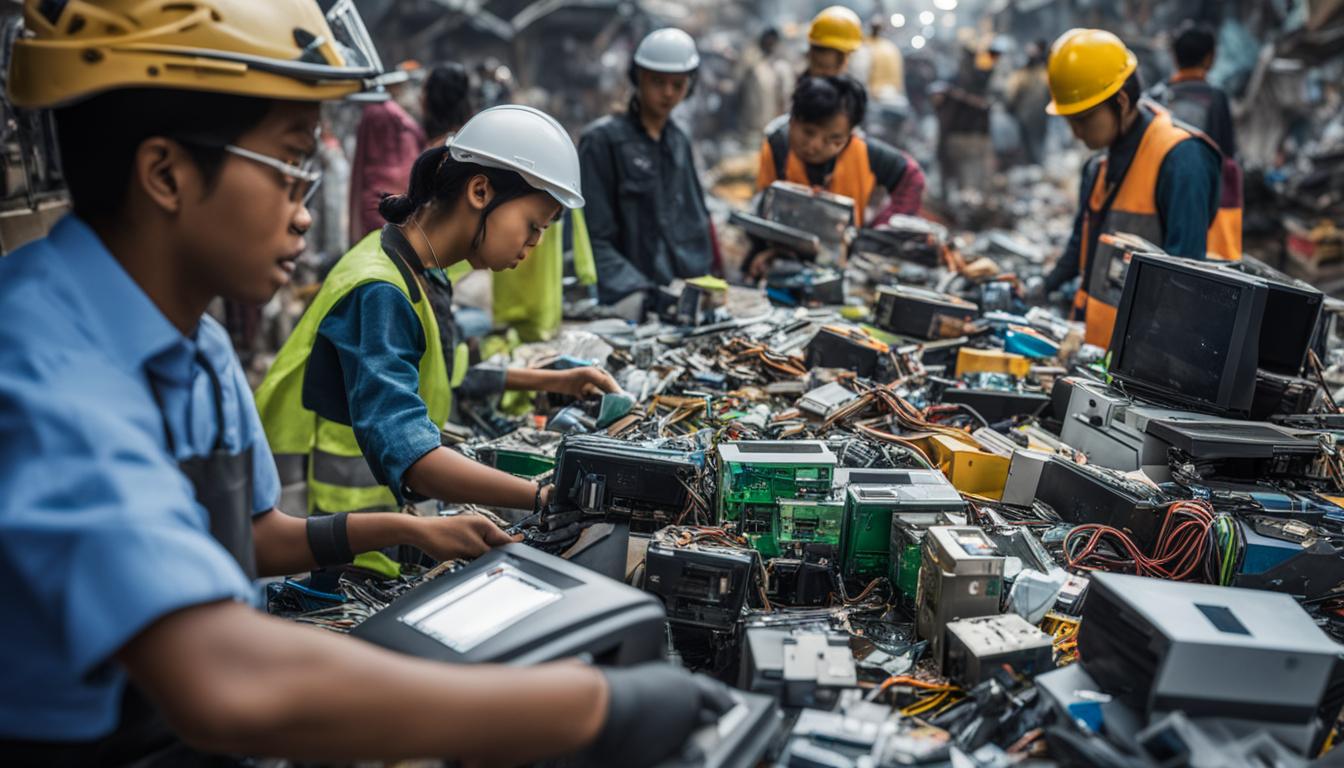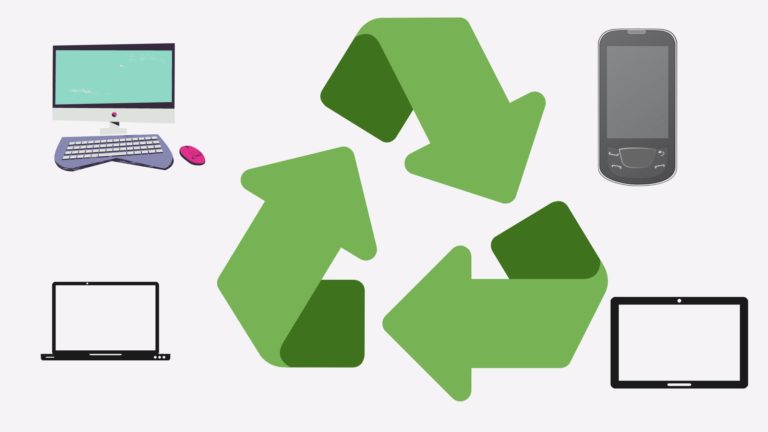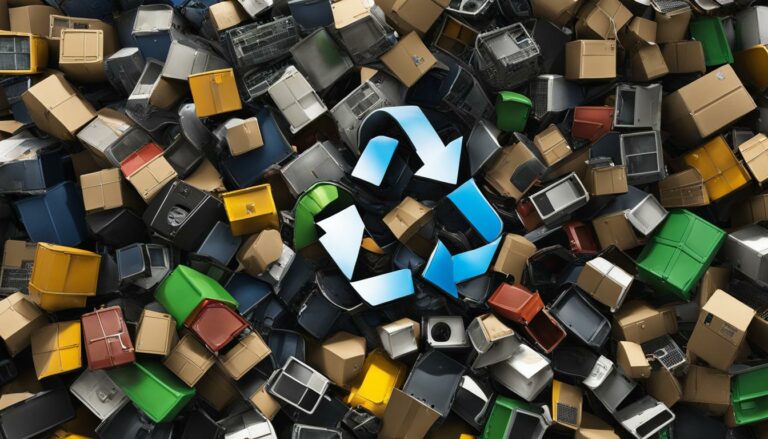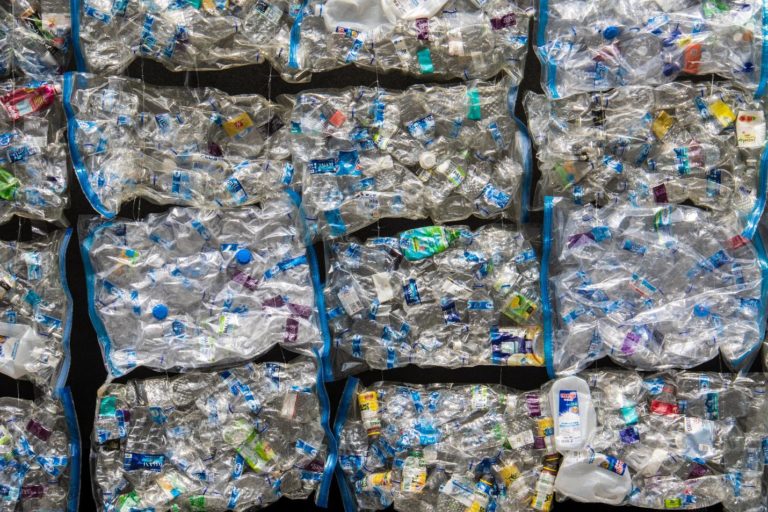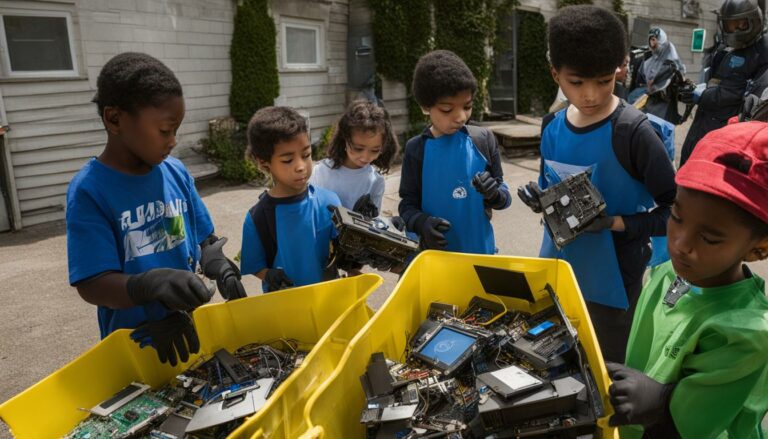Cutting-Edge Techniques in IT Materials Recovery
In today’s world, the proper management of electronic waste, or e-waste, is becoming increasingly important. Waste management companies are implementing cutting-edge techniques to recover valuable materials from IT assets and reduce the environmental impact of e-waste. These techniques include IT asset recovery, materials recycling, data erasure, and electronic waste disposal. By employing these innovative methods, companies can ensure the secure and sustainable recovery of IT materials.
Key Takeaways
- IT materials recovery is crucial in reducing the environmental impact of e-waste.
- Techniques such as IT asset recovery, materials recycling, data erasure, and electronic waste disposal play a significant role.
- Secure data erasure ensures the proper destruction of sensitive information.
- Environmental IT solutions focus on responsible e-waste disposal and recycling.
- Sustainable IT practices contribute to a greener future.
IT Asset Recovery and Materials Recycling
When it comes to managing electronic waste, IT asset recovery and materials recycling are essential techniques that play a vital role in minimizing environmental impact and promoting sustainability. IT asset recovery involves the identification and retrieval of valuable materials from end-of-life IT assets. This process ensures that usable components are salvaged and repurposed, reducing the need for new materials.
Materials recycling, on the other hand, focuses on the sustainable processing of e-waste to recover valuable resources. It involves the disassembly and sorting of IT assets, facilitating the reuse of components and the recycling of metals and other materials. By implementing IT asset recovery and materials recycling techniques, companies can effectively reduce waste, conserve resources, and contribute to a circular economy.
“IT asset recovery and materials recycling are crucial steps towards sustainable waste management in the IT industry. By salvaging valuable materials and recycling electronic waste, we can minimize environmental impact and promote resource conservation.”
Implementing these techniques requires a systematic approach. First, IT assets are evaluated to identify components that can be reused or repurposed. Usable components are carefully extracted and refurbished, extending their lifespan and reducing the need for new production. The remaining materials are then processed through materials recycling, where valuable resources like metals and plastics are recovered.
| Benefits of IT Asset Recovery and Materials Recycling |
|---|
| 1. Resource Conservation: By reusing components and recycling materials, IT asset recovery and materials recycling minimize the demand for new resources. |
| 2. Waste Reduction: These techniques divert electronic waste from landfills, reducing the environmental burden. |
| 3. Economic Advantages: IT asset recovery can generate revenue through the sale of refurbished components, while materials recycling can provide a source of valuable resources. |
| 4. Environmental Protection: By reducing the extraction of raw materials and the production of new components, these techniques help mitigate pollution and greenhouse gas emissions. |
Overall, IT asset recovery and materials recycling are integral to sustainable waste management in the IT industry. By salvaging valuable materials, reducing waste, and promoting the reuse of components, these techniques contribute to a more environmentally responsible approach to IT materials recovery.
References
- “The Importance of IT Asset Recovery and Recycling,” Green Computing & Sustainability Journal
- “Sustainable IT Asset Management,” Environmental and Energy Management Journal
Secure Data Erasure
Data security is a critical concern in IT materials recovery. Companies must ensure that sensitive information is properly destroyed before IT assets are recycled or repurposed. Secure data erasure techniques play a vital role in this process, guaranteeing that no recoverable data remains on the devices. By implementing these techniques, companies can protect sensitive data and ensure compliance with data protection regulations.
There are two main methods of secure data destruction: data wiping and physical destruction. Data wiping involves the complete removal of all data from a device by overwriting it with random information. This process ensures that the original data cannot be recovered using any software or hardware techniques. Physical destruction, on the other hand, involves physically damaging the device to render it unusable and inaccessible. This method is commonly used for devices that cannot be effectively wiped or for those that contain highly sensitive information.
“Secure data erasure is crucial in IT materials recovery to protect against data breaches and unauthorized access. By securely wiping or physically destroying data, companies can prevent valuable information from falling into the wrong hands.”
Data Erasure Standards
Several industry standards define the secure data erasure process. The most commonly used standards include the National Institute of Standards and Technology (NIST) Special Publication 800-88, the British HMG Infosec Standard No. 5, and the Guidelines for Media Sanitization developed by the National Industrial Security Program Operating Manual (NISPOM) in the United States. These standards provide guidelines on the process and verification of data erasure, ensuring that companies follow best practices to protect sensitive information.
The Importance of Secure Data Erasure
Secure data erasure is essential for several reasons. Firstly, it helps companies comply with data protection regulations such as the General Data Protection Regulation (GDPR) in the European Union. Failure to properly erase data can result in hefty fines and damage to a company’s reputation. Secondly, secure data erasure minimizes the risk of data breaches and unauthorized access to sensitive information. This is particularly important for industries that handle confidential customer data, such as banking, healthcare, and e-commerce. Finally, data erasure allows companies to repurpose or recycle IT assets without the fear of data leakage, contributing to a more sustainable approach to materials recovery.
| Data Erasure Method | Advantages | Disadvantages |
|---|---|---|
| Data Wiping | – Allows for device reuse – Environmentally friendly – Cost-effective |
– Time-consuming – Requires specialized software |
| Physical Destruction | – Ensures complete data destruction – Suitable for highly sensitive information |
– Renders the device unusable – Disposal challenges for electronic waste |
Electronic Waste Disposal
The proper disposal of electronic waste, also known as e-waste, is of utmost importance in today’s world. With the rapid advancement of technology and the increasing demand for electronic devices, the volume of e-waste generated has reached alarming levels. Environmental IT solutions focus on addressing this issue by implementing responsible and sustainable practices for the disposal of electronic waste. By adopting these solutions, companies can minimize the environmental impact of e-waste and contribute to a greener future.
Environmental IT solutions for electronic waste disposal involve the safe handling, recycling, and proper disposal of IT assets in compliance with regulations. These solutions prioritize the recycling of valuable materials from e-waste, such as metals, plastics, and rare earth elements, reducing the need for raw materials extraction. By recovering and reusing these materials, the environmental footprint of e-waste is significantly reduced, conserving resources and minimizing the energy and carbon emissions associated with manufacturing new products.
“Proper disposal of electronic waste is not only an environmental responsibility but also a legal requirement. By adopting environmental IT solutions, companies ensure compliance with regulations and prevent potential penalties or reputational damage.”
Additionally, environmental IT solutions prioritize the safe handling and disposal of hazardous materials found in electronic waste, such as mercury, lead, and brominated flame retardants. These materials can be harmful to human health and the environment if not properly managed. By employing appropriate disposal methods, companies can prevent the release of these hazardous substances into the environment, protecting both ecosystem health and human well-being.
Table: Benefits of Environmental IT Solutions for Electronic Waste Disposal
| Benefits | |
|---|---|
| Minimize environmental impact | Implement responsible practices for e-waste disposal, reducing pollution and conserving resources. |
| Compliance with regulations | Ensure proper disposal of e-waste to meet legal requirements and prevent potential penalties. |
| Resource conservation | Recover valuable materials from e-waste, reducing the need for raw materials extraction. |
| Hazardous material management | Safely handle and dispose of hazardous substances found in electronic waste, protecting human health and the environment. |
| Ecosystem protection | Prevent the release of harmful substances into the environment, preserving ecosystem health. |
By embracing environmental IT solutions for electronic waste disposal, companies can take an active role in minimizing the environmental impact of e-waste. These solutions not only contribute to a more sustainable future but also enhance corporate social responsibility and promote a positive public image. As technology continues to advance, it is crucial for businesses to prioritize the responsible management of electronic waste and seize the opportunity to make a difference.

Sustainable IT Practices and Environmental Solutions
In today’s world, as businesses strive to become more environmentally conscious, sustainable IT practices and environmental solutions are becoming increasingly important. These practices encompass a holistic approach to IT materials recovery, focusing on energy-efficient systems, responsible procurement and asset management, and the promotion of recycling and reuse. By adopting sustainable IT practices, companies can reduce their carbon footprint and contribute to a greener future.
One key aspect of sustainable IT practices is the use of energy-efficient systems. By employing technologies that consume less power, businesses can minimize their energy consumption and reduce their impact on the environment. This includes implementing power-saving features, utilizing virtualization to optimize server resources, and adopting energy-efficient hardware and components.
Another important element of sustainable IT practices is responsible procurement and asset management. This involves considering the environmental impact of IT equipment during the procurement process and selecting vendors that adhere to sustainable practices. Additionally, companies can implement asset management strategies that extend the life cycle of IT assets, such as refurbishing, upgrading, or repurposing equipment instead of disposing of it prematurely.
The promotion of recycling and reuse is also a key component of sustainable IT practices. By encouraging the recycling of IT assets and components, companies can minimize the generation of electronic waste and conserve valuable resources. This can be achieved through partnerships with certified e-waste recycling facilities, implementing take-back programs for old equipment, and promoting the reuse and refurbishment of IT assets.
Benefits of Sustainable IT Practices
Adopting sustainable IT practices not only benefits the environment but also brings numerous advantages for businesses. These include:
- Cost savings through energy efficiency and responsible asset management
- Enhanced brand reputation as a socially responsible and environmentally conscious company
- Compliance with environmental regulations and standards
- Reduced reliance on finite resources through recycling and reuse
- Improved employee morale and engagement through participation in sustainability initiatives
Environmental IT Solutions
In addition to sustainable IT practices, companies can also explore environmental IT solutions to further minimize their environmental impact. These solutions focus on the use of renewable energy, eco-friendly materials, and innovative technologies. By harnessing renewable energy sources such as solar or wind power, businesses can reduce their reliance on fossil fuels and decrease their carbon emissions. Furthermore, the adoption of eco-friendly materials, such as biodegradable packaging or low-impact manufacturing processes, can help minimize the environmental footprint of IT operations.
Embracing innovative technologies, such as server virtualization or cloud computing, can also contribute to environmental sustainability. These technologies enable businesses to optimize resource utilization, reduce hardware requirements, and achieve greater energy efficiency. Additionally, the implementation of smart energy management systems can provide real-time monitoring and control of energy consumption, further enhancing the environmental performance of IT infrastructure.
Conclusion
IT Materials Recovery Techniques are pivotal in driving innovation and paving the way towards a sustainable future. By implementing these innovative solutions such as IT asset recovery, materials recycling, secure data erasure, and responsible electronic waste disposal, companies can effectively manage IT materials while minimizing their environmental impact.
Through the adoption of IT asset recovery and materials recycling, valuable materials can be retrieved from end-of-life IT assets, reducing the demand for new resources. This sustainable approach promotes the reuse of components and the recycling of metals and other materials, contributing to a circular economy.
Data security is a crucial consideration, and secure data erasure techniques ensure that sensitive information is completely destroyed before IT assets are repurposed or recycled. By implementing secure data destruction methods such as data wiping and physical destruction, companies can protect sensitive data and comply with data protection regulations.
Responsible electronic waste disposal is paramount to prevent negative environmental impacts. Environmental IT solutions enable the responsible recycling and disposal of IT assets, ensuring that hazardous materials are handled safely and minimizing the overall environmental footprint of e-waste. By embracing these techniques, companies can contribute to a more sustainable future and help build a greener world.
FAQ
What is IT asset recovery?
IT asset recovery involves the identification and retrieval of valuable materials from end-of-life IT assets to be salvaged and repurposed.
What is materials recycling?
Materials recycling focuses on the sustainable processing of e-waste to recover valuable resources through the disassembly and sorting of IT assets.
Why is data erasure important in IT materials recovery?
Secure data erasure techniques ensure that sensitive information is properly destroyed before IT assets are recycled or repurposed, protecting sensitive data and ensuring compliance with data protection regulations.
What does electronic waste disposal involve?
Electronic waste disposal includes the responsible recycling and disposal of IT assets in compliance with regulations and environmentally friendly practices to minimize the environmental impact of e-waste.
What are sustainable IT practices?
Sustainable IT practices encompass energy-efficient IT systems, responsible procurement and asset management, and the promotion of recycling and reuse to reduce the carbon footprint of IT operations.
How do environmental IT solutions contribute to a greener future?
Environmental IT solutions emphasize the use of renewable energy, eco-friendly materials, and innovative technologies to minimize the environmental impact of IT operations and contribute to a more sustainable future.






